A white paper issued by Greenpeace India and the Citizen Response Group highlighted widespread nurdle contamination along the coasts of Kerala, Tamil Nadu, and Sri Lanka, resulting in severe ecological degradation and livelihood disruptions for coastal communities.
Published Jul 29, 2025 | 9:00 AM ⚊ Updated Jul 29, 2025 | 9:00 AM

The protest by fisherfolk against MSC on 27 July at Muthalapozhi, Thiruvananthapuram.
Synopsis: Fishermen in Kerala are a worried lot. Two maritime accidents have led to a sharp decline in the catch of staple fish varieties. Additionally, the drifting containers from the shipwrecks have caused extensive damage to fishing nets and fibre boats, inflicting losses worth lakhs of rupees.
While the Union and state governments maintain that the recent shipwrecks off the Kerala coast have had no adverse impact on fishing activities, voices from the shoreline tell a different story.
For the sea-dependent coastal communities, the sinking of MSC ELSA 3 on 24–25 May and the fire accident on MV Wan Hai 503 on 9 June have brought not just wreckage, but ruin.
Fishermen alleged a sharp decline in the catch of staple fish varieties like Indian mackerel (locally called ayala), sardine (mathi), and anchovy (kozhuva/netholi) following the incidents, contradicting the findings of institutions like ICAR-Central Institute of Fisheries Technology (CIFT), ICAR-Central Marine Fisheries Research Institute (CMFRI), and Kerala University of Fisheries and Ocean Studies (KUFOS).
Beyond the dwindling catch, they said, the drifting containers from the shipwrecks have caused extensive damage to fishing nets and fibre boats, inflicting losses worth lakhs of rupees.
On 27 June, in what is being seen as the first visible protest by Kerala’s fisherfolk over the fallout of these maritime accidents, the affected communities took to the seas, demanding compensation for lost livelihoods and damaged equipment.
Now, organisations like Greenpeace India, Citizen Response Group, and the Coastal Students Cultural Forum have stepped in, joining hands with the fishermen to amplify their voices to reclaim their right to the sea.
Of the two recent maritime incidents off Kerala’s coast, the wreck of MSC ELSA 3 has dealt the biggest blow to the state’s traditional fishing community, said Jackson Pollayil, secretary of the Kerala Swathanthra Matsya Thozhilali Federation.
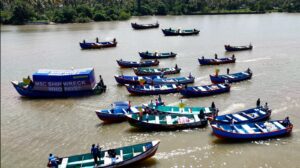
Fisherfolk affected by the maritime accidents took to the seas, demanding compensation for lost livelihoods and damaged equipment.
“The shipwreck occurred around 39 nautical miles south of Kochi, in a zone that is crucial for deep-sea fishing,” Jackson told South First, “And the state government imposed a blanket ban on fishing activities within a 20-nautical-mile radius of the wreckage. This has severely impacted the livelihood of fisherfolk.”
Even beyond the exclusion zone, the damage hasn’t stopped.
“Floating debris, including containers and other wreckage, continues to damage fishing nets and boats. Over 40 fishing boats have sustained significant damage. Several nets have been torn,” Jackson said, adding that each damaged boat affects 20 to 40 fishers, impacting an entire chain of dependent families.
He alleged that neither the state government nor MSC has taken meaningful steps toward compensation or accountability.
“Everyone seems to be turning a blind eye. There’s no serious discussion on corporate responsibility or relief. The fisherfolk are being abandoned,” he alleged.
Jackson also voiced concerns over a drastic fall in the catch of small pelagic species, including mackerel, sardine, and anchovy — fish that form the backbone of Kerala’s seafood economy.
“We’ve seen a shocking drop in sardine catch. Authorities are ruling out oil spills or chemical contamination. But we strongly suspect that the wreck and its aftermath are influencing marine life,” he observed.
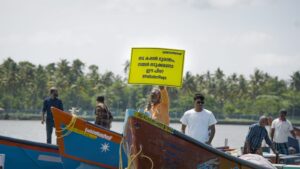
A fisherman during the protest on 27 July, asking who should pay the price?
Sardines are especially sensitive to changes in sea temperature, noise pollution, and even disturbances in their environment. Studies have shown that they often migrate away from disturbed zones, affecting catch volumes.
“If this migration trend continues, we’re looking at a bigger, long-term crisis — not just for us but for Kerala’s entire marine ecosystem,” he warned.
The temporary fishing ban, combined with fears of contamination, has caused a collapse in the seafood market. With no substantial government intervention so far, fisherfolk are now staring at a bleak and uncertain future.
“This disaster has robbed us of our livelihood, food security, and dignity. MSC must be held accountable. The government needs to step up compensation and ensure corporate responsibility,” said Jackson.
“Even as the trawling ban is set to be lifted on 31 July, many in the fishing community fear that consumer hesitation over possible contamination will continue to affect fish sales. ‘People are still unsure whether the fish from these waters are safe to eat,’ Jackson said.
It’s against this backdrop of concerns that on Sunday, 27 July, over 80 people, including members of the fishing community from Muthala Pozhi – Perumathura, in Thiruvananthapuram, came together with 20 boats for a powerful and symbolic visual protest, featuring a floating banner with the message “MSC Shipwreck, Who Pays?”
On Monday, 28 July, Greenpeace India and the Citizen Response Group released a white paper documenting the devastating environmental and social fallout from a maritime disaster spanning 25 May to 25 June.
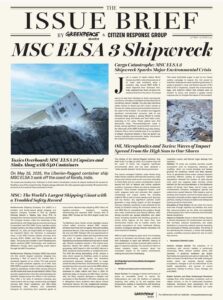
A part of the whitepaper released on Monday, 28 July.
The report highlights widespread nurdle contamination along the coasts of Kerala, Tamil Nadu, and Sri Lanka, resulting in severe ecological degradation and livelihood disruptions for coastal communities.
Nurdles—tiny plastic pellets used in manufacturing—have washed ashore in large quantities across sensitive areas like Kovalam, Kollam, Alappuzha, and even the Gulf of Mannar Marine Biosphere Reserve, posing long-term threats to marine biodiversity.
This whitepaper warned that these primary microplastics absorb toxins, and are mistaken as food by fish, seabirds, and sea turtles, and ultimately cause internal injuries, starvation, and toxin exposure.
Equally alarming is the presence of 12 containers of calcium carbide.
It highlighted that when in contact with seawater, it generates acetylene gas and calcium hydroxide, raising pH levels and severely disrupting aquatic life. The white paper warned that the oil slicks from the incident can smother mangroves, estuaries, and coral reefs—vital breeding grounds for marine species—leading to irreversible ecological damage.
Contamination during the monsoon breeding season would worsen the crisis, threatening fish stocks and endangering species from plankton to marine mammals.
Calling the incident “corporate negligence,” Greenpeace demanded that MSC support an independent environmental and social impact assessment and provide fair compensation to affected communities.
“MSC must not be allowed to walk away from this,” said Greenpeace campaigner Aakiz Farooq. “They should pay for every bit of this damage to the sea and the communities that depend on it.”
Meanwhile, on 22 July, in a written reply in the Lok Sabha, Union Minister of State for Fisheries George Kurian revealed that the Kerala government has taken prompt and comprehensive steps to assess and mitigate any potential ecological impacts threatening the state’s marine ecosystem and the livelihood of its fisherfolk.
As per the response, a high-level meeting was convened on 28 May 2025, bringing together top scientists from ICAR-Central Institute of Fisheries Technology (CIFT), ICAR-Central Marine Fisheries Research Institute (CMFRI), Kerala University of Fisheries and Ocean Studies (KUFOS), and representatives of the fishing community.
The meeting aimed to assess ecological concerns and chart a plan for protecting fishery resources and the coastal population dependent on them.
Subsequently, on 19 June 2025, the state government constituted a Joint Coordination Committee, comprising representatives from KUFOS, CMFRI, CIFT, the State Pollution Control Board, Food Safety Department, National Health Mission, and the Coastal Police.
The committee was tasked with conducting rigorous sampling and testing of seawater and fish along Kerala’s coastline, adhering to standard scientific protocols.
To further strengthen the response, the National Institute of Oceanography (NIO) has been entrusted, through the Environment Department of Kerala, to conduct a comprehensive multi-sectoral assessment, covering both short-term and long-term ecological and economic impacts.
According to the Directorate General of Shipping, preparations for the next phase of salvaging the sunken MSC ELSA 3 have intensified, with final mobilisation underway in Singapore.
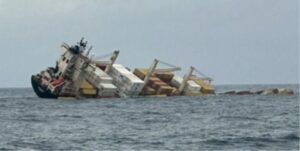
Liberia-flagged MSC ELSA-3 sank off the Kerala coast on 25 May. (KSDMA)
The DP2 Diving Support Vessel, equipped with a saturation diving system, is en route to the wreck site and will begin offshore diving operations immediately upon arrival, without entering port.
Kollam Port has been selected as the logistical hub for its proximity, 7-meter draft, and prior support to salvage efforts. Immigration clearance is being facilitated through the Foreigner Regional Registration Office, Thiruvananthapuram, with full state and port authority backing.
As of 18 July, 557 metric tonnes of nurdles have been collected from affected shorelines, with 266 MT already moved to the Kollam warehouse. Segregation of the remaining nurdles is ongoing.
The mobilisation of the vessel Southern Nova marks the shift to high-risk deep-sea fuel extraction and underwater operations, requiring seamless logistical and regulatory coordination.
Meanwhile, the Marine Environment Response Centre (MERC) has reiterated the need for Tamil Nadu’s directive on disposing of stored nurdles in Kannyakumari, which remains pending.
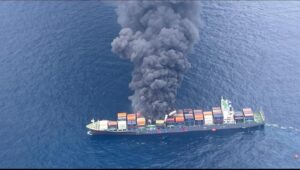
MV Wan Hai 503 on fire
In a parallel development, the Wan Hai 503 remains under tow outside India’s EEZ, around 90 nautical miles from the boundary, managed by the tug, Offshore Warrior.
With operational responsibility transitioning to Singapore, India’s Directorate General of Shipping made it clear that it will conclude its coordination once the vessel fully exits the EEZ.
The Maritime and Port Authority of Singapore has mandated a forward towing connection before permitting the vessel’s entry into a port. Salvors plan to establish this critical link using Virgo by 27–28 July 2025.
The maritime incidents involving MSC ELSA 3 and MV Wan Hai 503 have triggered a growing rift between official assurances and on-ground realities.
As salvage operations intensify and scientific studies continue, the crisis underscores the urgent need for transparent environmental assessments, timely relief measures, and recognition of the lived experiences of coastal communities whose livelihoods hinge on the health of the sea.
(Edited by Majnu Babu).
